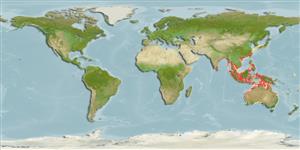Actinopterygii (ray-finned fishes) >
Perciformes (Perch-likes) >
Gobiidae (Gobies) > Amblyopinae
Etymology: Odontamblyopus: Greek, odous = teeth + Greek,amblys = darkness + Greek, pous = foot (Ref. 45335).
Environment / Climate / Range
Ecology
Marine; brackish; benthopelagic; amphidromous (Ref. 51243). Subtropical; 20°C - 30°C (Ref. 12468), preferred ?
Indo-West Pacific: India, Myanmar and Bangladesh. This species is not found in Indonesia, the Philippines or Ariake Sound.
Size / Weight / Age
Maturity: Lm ? range ? - ? cm
Max length : 25.0 cm TL male/unsexed; (Ref. 4833)
Dorsal
spines
(total): 6;
Dorsal
soft rays
(total): 34-41;
Anal
spines: 1;
Anal
soft rays: 32 - 39;
Vertebrae: 27. Eyes rudimentary but distinct, covered by skin. Mouth oblique. Several short barbels may be present on underside of chin. Pectoral -fin rays free and silk-like. Three anal fin pterygiophores preceding first haemal spine. Cycloid scales embedded on head and body. Caudal fin very long (Ref. 45323).
Occurs in coastal waters and estuaries (Ref. 4833).
Life cycle and mating behavior
Maturity | Reproduction | Spawning | Eggs | Fecundity | Larvae
Murdy, E.O. and K. Shibukawa, 2001. A revision of the gobiid fish genus Odontamblyopus (Gobiidae: Amblyopinae). Ichthyol. Res. 48(1):31-43. (Ref. 45323)
IUCN Red List Status (Ref. 115185)
CITES (Ref. 94142)
Not Evaluated
Threat to humans
Harmless
Human uses
Fisheries: minor commercial
More information
Common namesSynonymsMetabolismPredatorsEcotoxicologyReproductionMaturitySpawningFecundityEggsEgg development
ReferencesAquacultureAquaculture profileStrainsGeneticsAllele frequenciesHeritabilityDiseasesProcessingMass conversion
Tools
Special reports
Download XML
Internet sources
